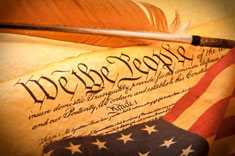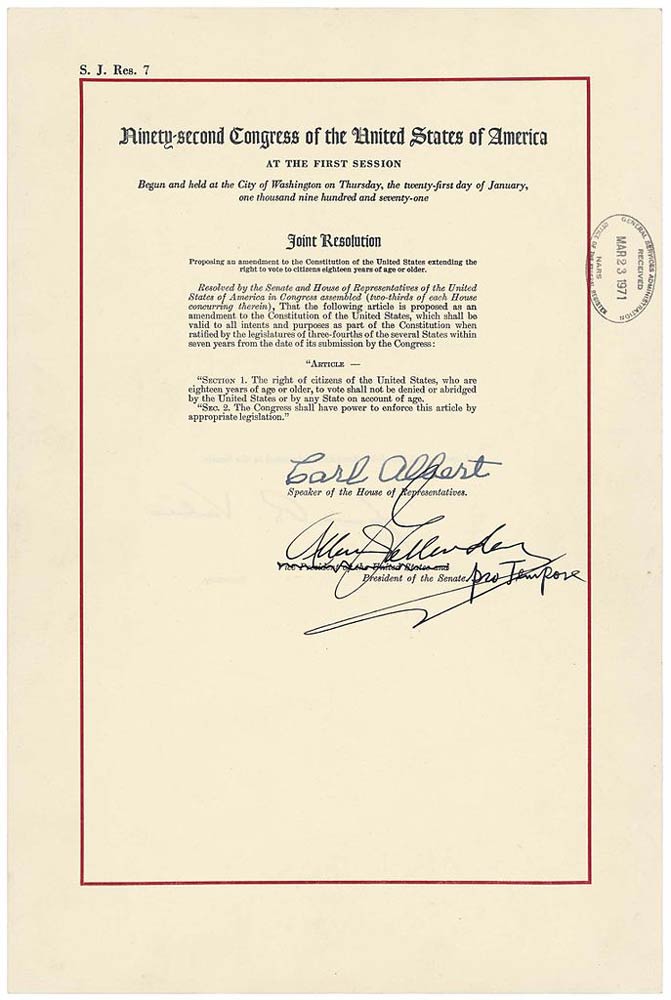| United States Constitution | |
|---|---|
 |
|
| The U.S. Constitution | |
| Preamble | |
| Articles of the Constitution | |
| I ‣ II ‣ III ‣ IV ‣ V ‣ VI ‣ VII | |
| Amendments to the Constitution | |
| Bill of Rights | |
| I ‣ II ‣ III ‣ IV ‣ V ‣ VI ‣ VII ‣ VIII ‣ IX ‣ X | |
| Additional Amendments | |
| XI ‣ XII ‣ XIII ‣ XIV ‣ XV ‣ XVI ‣ XVII ‣ XVIII ‣ XIX ‣ XX ‣ XXI ‣ XXII ‣ XXIII ‣ XXIV ‣ XXV ‣ XXVI ‣ XXVII | |
| View the Full Text | |
| Original Constitution | |
| Bill of Rights | |
| Additional Amendments |
From its beginnings in 1787, the U.S. Constitution has provided a powerful framework for the workings of the federal government. The purpose of Amendments to the Constitution is generally due to the changing nature of the country. Amendments can be proposed by anyone, but there is a long, difficult process from proposal to actual ratification. The Bill of Rights safeguards individual freedoms in the U.S. These were ratified in 1791. After these 10, the next Amendments dealt with issues such as slavery, voting rights, Presidential term limits, and prohibition. Then, on March 23, 1971, Congress passed the 26th Amendment, and it was ratified on July 1, 1971. This Amendment also dealt with voting rights. It lowered the voting age from 21 to 18.
Text
Section 1. The right of citizens of the United States, who are eighteen years of age or older, to vote shall not be denied or abridged by the United States or by any State on account of age.
Section 2. The Congress shall have the power to enforce this article by appropriate legislation.
The Proposal
There are two, brief sections worth noting. The first is that the right of citizens of the U.S., who are 18 years, or older, to vote. The second section simply states Congress has the power to enforce this article by means of legislation. It basically prohibits any state or the federal government from setting the voting age higher than 18.
History from WWII to Vietnam
 What led to the proposal of this particular Amendment, and how difficult or easy was its journey from proposal to ratification? To answer this question, one must look at what was going on in the U.S. during this time period that affected those aged 18 to 20 for why their right to vote needed to be instituted. Many believe that the Vietnam War was the trigger for this proposed Amendment. But the idea of lowering the voting age for all U.S. citizens to 18 began during the course of WWII, when Franklin Delano Roosevelt was president. He lowered the draft age to 18. A youth voting rights movement sprang up, and the words, “Old enough to fight, old enough to vote,” were heard throughout WWII, the Korean War, and the Vietnam War eras.
What led to the proposal of this particular Amendment, and how difficult or easy was its journey from proposal to ratification? To answer this question, one must look at what was going on in the U.S. during this time period that affected those aged 18 to 20 for why their right to vote needed to be instituted. Many believe that the Vietnam War was the trigger for this proposed Amendment. But the idea of lowering the voting age for all U.S. citizens to 18 began during the course of WWII, when Franklin Delano Roosevelt was president. He lowered the draft age to 18. A youth voting rights movement sprang up, and the words, “Old enough to fight, old enough to vote,” were heard throughout WWII, the Korean War, and the Vietnam War eras.
A democratic congressman from West Virginia, Jennings Randolph, was the first one to introduce federal legislation for lowering the voting age. Starting in 1942, Mr. Randolph, who was known as the “father” of this particular Amendment, sponsored it for eleven times. At the time of his death in 1998 he was the last surviving member of Congress known to have served during Roosevelt’s first 100 days.
The President to publicly announce his support for lowering the voting age to 18 was Dwight D. Eisenhower. In 1954, he spoke of those between the ages of 18 and 21 who fought for their country, summoned by draft or duty, and stated, “They should participate in the political process that produces this fateful summons.” He urged Congress to support a Constitutional Amendment to lower the voting age, but it was never done.
As the fifties drew to a close, and the sixties began, a new President was elected, and with him, the continuation of the cold war and the U.S. efforts to fight communism around the world. Kennedy took office, and on his death, Lyndon Johnson was sworn in. The turbulent sixties saw the beginnings of the U.S. involvement in Vietnam in order to protect South Vietnam from communism. With the many young men, ages 18 through 20, being drafted to fight in Vietnam, the right for those 18 and older to vote reached a new fervor.
The anti-war movement grew strong, with student activism playing a huge role, and renewed the push for lowering the legal voting age. The student group of the National Education Association teamed with other groups, such as the NAACP and the YMCA and created a youth franchise coalition. This coalition pushed for a Constitutional Amendment to lower the voting age.
The Supreme Court decided the bill was unconstitutional, and rather than face a conflict over federal vs. state/local decisions regarding voting age, Congress and state legislatures went ahead and started working on the amendment. The Senate proposed the Amendment by a total majority on March 10, 1971, and Congress passed it with a majority vote on March 23, 1971. Jennings Randolph was among those in the Senate when this happened. Four months later, the required 3/4 of State Legislatures ratified it, and in July, 1971, President Nixon signed it. The United States had its 26th Constitutional Amendment.
The 26th Amendment Today
At present time, the states Florida, Kentucky, Mississippi, Nevada, New Mexico, North Dakota, South Dakota, and Utah have not ratified this amendment. Although the end of the Vietnam War era saw the number of young voters winding down, this number increased significantly during the 2004 elections, and rose again in 2008. The same young people who are old enough to be drafted are old enough to vote today.